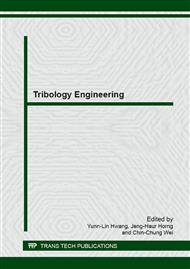[1]
J. N. Israelachvili. Intermolecular and surface forces. Academic Press London, (1992).
Google Scholar
[2]
R. G. Horn and J. N. Israelachvili. Direct measurement of structural forces between two surfaces in a nonpolar liquid. J. Chem. Phys., Vol. 75 (1981), p.1400–1412.
DOI: 10.1063/1.442146
Google Scholar
[3]
D. Y. C. Chan and R. G. Horn. The drainage of thin liquid films between solid surfaces. J. Chem. Phys., Vol. 83 (1985), p.5311–5324.
DOI: 10.1063/1.449693
Google Scholar
[4]
R. Y. H. Lim and S. J. O'Shea. Discrete solvation layering in confined binary liquids. Langmuir, Vol. 20 (2004), p.4916–4919.
DOI: 10.1021/la036200g
Google Scholar
[5]
H. Matsuoka and T. Kato. An ultrathin liquid film lubrication theory - calculation method of solvation pressure and its application to the ehl problem. J. Trib., Vol. 119 (1997), p.217–226.
DOI: 10.1115/1.2832464
Google Scholar
[6]
M. Al-Samieh and H. Rahnejat. Ultra-thin lubricating films under transient conditions. J. Phys D: App. Phys., Vol. 34 (2001), p.2610–2621.
DOI: 10.1088/0022-3727/34/17/307
Google Scholar
[7]
M. F. Abd. Al-Samieh and H. Rahnejat. Nano-lubricant film formation due to combined elastohydrodynamics and surface force action under isothermal conditions. Proc. IMechE, Part C : J. Mech. Eng. Sci., Vol. 215 (2001), p.1019–1029.
DOI: 10.1177/095440620121500902
Google Scholar
[8]
M. Al-Samieh and H. Rahnejat. Physics of lubricated impact of a sphere in a plate in a narrow continuum to gaps of molecular dimensions. J. Phys D: App. Phys, Vol. 35 (2002), p.2311– 2326.
DOI: 10.1088/0022-3727/35/18/313
Google Scholar
[9]
W. W. F. Chong, M. Teodorescu, and H. Rahnejat. Effect of lubricant molecular rheology on formation and shear of ultra-thin surface films. J. Phys D : App. Phys, Vol. 44 (2011):, p.165302.
DOI: 10.1088/0022-3727/44/16/165302
Google Scholar
[10]
W. W. F. Chong, M. Teodorescu, and H. Rahnejat. Formation of ultra-thin bi-molecular boundary adsorbed films. J. Phys., D: Appl. Phys., Vol. 45 (2012), p.115303.
DOI: 10.1088/0022-3727/45/11/115303
Google Scholar
[11]
W. W. F. Chong, M. Teodorescu, and H. Rahnejat. Physio-chemical hydrodynamic mechanism underlying the formation of thin adsorbed boundary films. Faraday Discuss, Vol. 156 (2012), p.123–136.
DOI: 10.1039/c2fd00118g
Google Scholar
[12]
D. J. Mitchell, B. W. Ninham, and B. A. Pailthorpe. Hard sphere structural effects in colloid systems. Chem. Phys Lett., Vol. 51 (1977), p.257–260.
DOI: 10.1016/0009-2614(77)80397-7
Google Scholar
[13]
D. Henderson and M. Lozada-Cassou. A simple theory for the force between spheres immersed in a fluid. J. Coll. Inter. Sci., Vol. 114 (1986), p.180–183.
DOI: 10.1016/0021-9797(86)90250-x
Google Scholar
[14]
P. Attard and J.L. Parker. Oscillatory solvation forces: A comparison of theory and experiment. J. Phy. Chem., Vol. 96 (1992), p.5086–5093.
DOI: 10.1021/j100191a063
Google Scholar
[15]
C.K. Buenviaje, S.R. Ge, M.H. Rafaillovich, and R.M. Overney. Atomic force microscopy calibration methods for lateral force, elasticity and viscosity. Mat. Res. Soc. Symp. Proc., Vol. 522 (1998), p.187–192.
DOI: 10.1557/proc-522-187
Google Scholar
[16]
G. Styles, R. Rahmani, H. Rahnejat, and B. Fitzsimons. In-cycle and life-time friction transience in piston ring-liner conjunction under mixed regime of lubrication. Int, J. Engine Res., doi: 10. 1177/1468087413519783.
DOI: 10.1177/1468087413519783
Google Scholar
[17]
H. Eyring. Viscosity, plasticity, and diffusion as examples of absolute reaction rates. J. Chem. Phys., Vol. 4 (1936), p.283.
Google Scholar
[18]
B. J. Briscoe and D. C. B. Evans. The shear properties of langmuir-blodgett layers. Proc. Roy. Soc. London. Ser. A, Math. and Phys. Sci., Vol. 380 (1982), p.389–407.
Google Scholar
[19]
M. He, A. Szuchmacher Blum, G. Overney, and R. M. Overney. Effect of inter- facial liquid structuring on the coherence length in nanolubrication. Phys. Rev. Lett., Vol. 88 (2002), p.154302.
DOI: 10.1103/physrevlett.88.154302
Google Scholar


